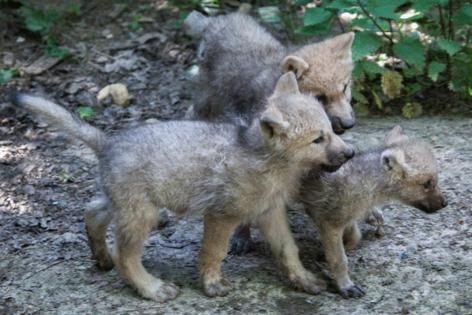Three wolf pups sought in California's Sierra Valley after parents euthanized
Published in News & Features
Three wolf pups from a pack whose adult members were euthanized by state conservation officials earlier this month had still not been captured despite weeks of searching by scientists and wildlife officers, the California Department of Fish and Wildlife said.
The slow progress of the search prompted concerns from environmental groups about the animals’ survival when harsh winter conditions descend on the Sierra rangeland where they are believed to still be living.
The roughly six-month-old juveniles, which will be taken to a wildlife sanctuary when located, are too small to take down most prey on their own and have lost their parents at the age when they would normally be learning how to hunt, wolf experts said.
“We can’t predict what will happen to these young wolves, although the odds of survival may be low,” said Pamela Flick, California program director for the conservation group Defenders of Wildlife. “Even if they survive the winter, they are losing out on fundamental lessons from their pack on how to survive as a wolf, and that will influence how they hunt, travel and behave into adulthood.”
The pups were born this year to adult members of the Beyem Seyo pack, which settled in Sierra Valley, about 100 miles northeast of Sacramento in Plumas and Sierra counties. The pack became unusually accustomed to feeding on livestock from nearby ranches, ultimately killing 87 cows, calves and sheep in just over six months, according to state wildlife officials.
Two weeks ago, after months of nonlethal efforts to dissuade the wolves from attacking livestock and venturing close to humans failed, game wardens with the California Department of Fish and Wildlife euthanized the pack’s three adult members and a pup they mistakenly thought was an adult.
The ongoing predation terrified residents of Sierra Valley and strained local law enforcement resources, highlighting a major challenge facing California and other states: Wolves, hunted to local extinction a century ago, are making a comeback under protections from both federal and state endangered species acts, but they also can threaten livestock and people.
But finding and carrying out the plan proved challenging. Only two of the adult wolves wore tracking collars, so the state’s first effort to kill one resulted in a mistake, as game wardens in a helicopter shot one of the juveniles instead of the uncollared adult they were seeking.
After that incident, the department changed its approach and shot the remaining three adults with tranquilizer darts rather than a firearm, then euthanized them on the ground with injections of the type a sick animal might receive when being put to sleep by a veterinarian.
Scientists later found the remains of two more pups that likely died of natural causes, leaving three living pups, all males, to be located and captured. But they have still not been caught, despite intense searches that began Sept. 24, said Jen Benedet, a spokeswoman for CDFW.
The pups, now considered juveniles by scientists, have been spotted from time to time and appear to be healthy, she said, meaning they have likely learned to forage for food.
The department is using several methods to locate them, she said, including combing areas the adults were known to frequent, following up on sightings by ranchers and residents, and using wildlife cameras to track their movements.
The four wolf specialists and several law enforcement officers are searching for the pups on the ground and by helicopter, she said. They are using drones as well as night-vision and thermal imaging equipment to try to spot the animals. The scientists are also engaging in what they call diversionary feeding — leaving out frozen carcasses of wild animals such as beavers for the wolves to find and eat, she said.
The pups are unlikely to be using the dens built by their parents, because typically those are used only for the first few months of life, Benedet said. These pups no longer show evidence of using the dens, she said.
If the pups are not found, there are a few likely scenarios regarding what could happen next, said Christine Barton, executive director of the California Wolf Center.
Typically, she said, wolves stay with the pack into which they were born until they are about 2 years old. At six months, they would be weaned and eating solid food, but would not have been on many hunts with the adults to learn how to take down prey.
As a result, they are likely to stay in the general vicinity of Sierra Valley for about three months and then disperse to other areas, looking for new packs to join, she said.
“Wolves can cover more than 50 miles in a day, so it’s hard to predict where they might go if they choose to leave,” Flick said. “They will seek out available prey, so they could end up covering a lot of terrain to find food.”
A major challenge if they are not captured will be to survive the harsh Sierra Valley winter, Barton and Flick said. To make it, they will have to learn to forage or take down smaller prey.
“Juvenile wolves of this age and size cannot take down large prey like a pack can, so they will likely scavenge on carcasses they come across or hunt smaller, easier prey like rodents and rabbits,” Flick said.
If the pups are not caught and they survive the winter, they may also stay in Sierra Valley, perhaps being joined by wolves from other packs to form a new group, Flick said. Wolves from two other packs were spotted in the range area of the Beyem Seyo pack last summer, she said, including members of the Diamond pack.
If that happens, the new pack may also begin to prey on local livestock, creating new tensions with the community.
To avoid such an outcome, the state plans to continue looking for the pups as long as possible, with the understanding that if they are not found soon, winter weather may disrupt the search, Benedet said.
“CDFW’s intended action is to continue to safely collect the outstanding juveniles and place them in an appropriate care facility, for their well-being and to prevent their learned behavior from dispersing to other packs across California,” she said.
_____
©2025 The Sacramento Bee. Visit sacbee.com. Distributed by Tribune Content Agency, LLC.







Comments